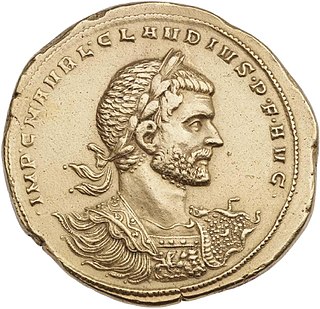
Publius Licinius Egnatius Gallienus was Roman emperor with his father Valerian from 253 to 260 and alone from 260 to 268. He ruled during the Crisis of the Third Century that nearly caused the collapse of the empire. He won numerous military victories against usurpers and Germanic tribes, but was unable to prevent the secession of important provinces. His 15-year reign was the longest in half a century.
The 270s decade ran from January 1, 270, to December 31, 279.

Year 271 (CCLXXI) was a common year starting on Sunday of the Julian calendar. At the time, it was known as the Year of the Consulship of Aurelianus and Bassus. The denomination 271 for this year has been used since the early medieval period, when the Anno Domini calendar era became the prevalent method in Europe for naming years.
The 250s was a decade that ran from January 1, 250, to December 31, 259.
The 260s decade ran from January 1, 260, to December 31, 269.

Septimia Zenobia was a third-century queen of the Palmyrene Empire in Syria. Many legends surround her ancestry; she was probably not a commoner, and she married the ruler of the city, Odaenathus. Her husband became king in 260, elevating Palmyra to supreme power in the Near East by defeating the Sasanian Empire of Persia and stabilizing the Roman East. After Odaenathus' assassination, Zenobia became the regent of her son Vaballathus and held de facto power throughout his reign.

Year 273 (CCLXXIII) was a common year starting on Wednesday of the Julian calendar. At the time, it was known as the Year of the Consulship of Tacitus and Placidianus. The denomination 273 for this year has been used since the early medieval period, when the Anno Domini calendar era became the prevalent method in Europe for naming years. The year also saw most lost territories to rebellion returned to the Roman Empire by Emperor Aurelian.

Marcus Aurelius Claudius "Gothicus", also known as Claudius II, was Roman emperor from 268 to 270. During his reign he fought successfully against the Alemanni and decisively defeated the Goths at the Battle of Naissus. He died after succumbing to a "pestilence", possibly the Plague of Cyprian that had ravaged the provinces of the Empire.
The Battle of Naissus in 268 or 269 was the defeat of a Gothic coalition by the Roman Empire under Emperor Gallienus and the future Emperor Aurelian near Naissus (Niš). The events around the invasion and the battle are an important part of the history of the Crisis of the Third Century.

Nicopolis or Actia Nicopolis was the capital city of the Roman province of Epirus Vetus. It is located near Preveza, Greece. The city was founded in 29 BC by Octavian in commemoration of his victory in 31 BC over Antony and Cleopatra at the Battle of Actium nearby.

Septimius Odaenathus was the founder king (malik) of the Palmyrene Kingdom who ruled from Palmyra, Syria. He elevated the status of his kingdom from a regional center subordinate to Rome into a formidable state in South-West Asia. Odaenathus was born into an aristocratic Palmyrene family that had received Roman citizenship in the 190s under the Severan dynasty. He was the son of Hairan, the descendant of Nasor. The circumstances surrounding his rise are ambiguous; he became the lord (ras) of the city, a position created for him, as early as the 240s and by 258, he was styled a consularis, indicating a high status in the Roman Empire.

Septimius Vaballathus was emperor of the Palmyrene Empire centred at Palmyra in the region of Syria. He came to power as a child under his regent mother Zenobia, who led a revolt against the Roman Empire and formed the independent Palmyrene Empire.
The Gothic Wars were a long series of conflicts between the Goths and the Roman Empire between the years 249 and 554. The main wars are detailed below.

The Battle of Immae was fought in 272 between the Roman army of Emperor Aurelian, and the armies of the Palmyrene Empire, whose leader, Empress Zenobia, had usurped Roman control over the eastern provinces.

The Palmyrene Empire was a short-lived breakaway state from the Roman Empire resulting from the Crisis of the Third Century. Named after its capital city, Palmyra, it encompassed the Roman provinces of Syria Palaestina, Arabia Petraea, and Egypt, as well as large parts of Asia Minor.

Maeonius, or Maconius, was a usurper who, according to the Historia Augusta, briefly ruled over Palmyra. He is included in the list of the Thirty Tyrants.

The History of the Constitution of the Late Roman Empire is a study of the ancient Roman Empire that traces the progression of Roman political development from the abolition of the Roman Principate around the year 200 until the fall of the Western Roman Empire in 476 CE. When Diocletian became Roman Emperor in 284 CE, he inherited a constitution that was no longer functioning, and so he enacted the most significant constitutional reforms in over 300 years. His reforms, much like those 300 years before, were intended to correct the errors in the previous constitution. Diocletian's specific reforms were less radical than was the reality that he exposed the state of government for what it had been for centuries: monarchy. With Diocletian's reforms the Principate was abolished, and a new system, the Dominate, was established.

Septimius Herodianus or Hairan I was a son and co-king of Odaenathus of Palmyra. Through his father's marriage to Zenobia, Hairan I had two half-brothers, Hairan II and Vaballathus.

Odaenathus, the king of Palmyra from 260 to 267 CE, has been identified by modern scholars as the subject of sculptures, seal impressions, and mosaic pieces. His city was part of the Roman Empire, and he came to dominate the Roman East when in 260 he defeated Shapur I, the Sasanian emperor of Persia, who had invaded the Roman Empire. Odaenathus besieged the Sasanian capital Ctesiphon in 263, and although the city did not fall, the campaign led to a full restoration of Roman provinces taken by Shapur I. In the aftermath of his Persian war, Odaenathus assumed the title King of Kings, which was a challenge to the Persian monarch's claims of authority in the region. Odaenathus ruled the Roman East unopposed with imperial consent. In 267, he was assassinated alongside his eldest son Herodianus while conducting a campaign against Germanic raiders in Bithynia; he was succeeded by his son Vaballathus under the regency of the widow queen Zenobia.
Timolaus of Palmyra was reportedly a 3rd century Palmyrene nobleman, son of the king of kings Odaenathus and augustus Zenobia. Little is known about him, and all the existing information comes from speculation. Such is the doubt of his existence that some scholars try to associate him with Vaballathus, another of the sons of Odaenathus and Zenobia. Some authors believe he is an individual made up by the Historia Augusta, the only historical source that cites him, and some speculate that he is in fact a historical figure. He appears only in 267, at the time of his father's assassination.














